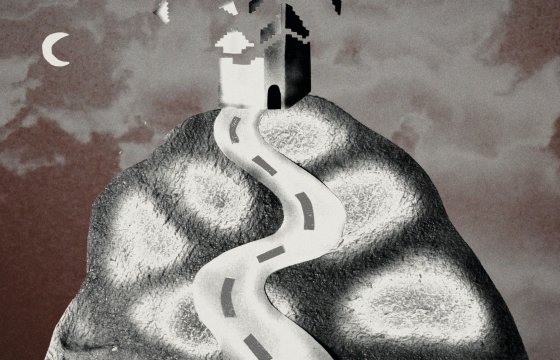
Creative Boom is on the ground at Glastonbury Festival, where the art-led Shangri-La area has just opened its gates. Here’s why those without tickets should care.
So here’s the thing about art galleries. Typically, they’re the antithesis of what art should be. Sterile, white-walled mausoleums where people shuffle around in hushed reverence, pretending to understand why a blue square is worth more than most people’s houses.
To my mind, art should be vibrant, messy, alive, and invigorating. It should make you think while you’re having a laugh. Well, that’s precisely what you’ll find in Shangri-La, the quirky south-east corner of Glastonbury, which has once again turned into the most subversive and interesting “art gallery” on the planet.
I put those words in quotes because many festivalgoers won’t actually recognise their surroundings as art and just think of it as “crazy weird stuff”. But that’s okay. In fact, it’s understandable. Because this year, Shangri-La has really gone for it.
Everything has gone
Last year’s Shangri-La theme, Everything Must Go!, was already pushing boundaries harder than a drunken teen stumbling into the wrong tent. But with this year’s fresh theme of “The Wilding”, it feels like they’ve torn up the rule book, set it on fire, and planted wildflowers in the ashes.
In the words of Shangri-La’s creative director Kaye Dunnings: “When we said in 2024 ‘Everything Must Go’, we meant it; everything has gone. The Wilding is a complete reset.”
She wasn’t kidding. Gone are the familiar dystopian street scenes and consumer hellscapes of previous years. Instead, we’ve got this sprawling natural wonderland that’s somehow even more radical and thought-provoking than before.



What’s exciting about this year’s outdoor installations is how they’ve managed to be both gorgeous and meaningful without being preachy. Take Amnesty International’s ‘Threads of Resistance’. It’s this incredible interactive tree sculpture where festivalgoers can add their own messages of solidarity with women worldwide.
Sounds potentially worthy and dull, right? Wrong. It’s actually very moving watching people from all walks of life contributing to this growing artwork of hope and defiance.
Then there’s Ellie Davies’ billboard series scattered throughout the space. Ellen has been working in UK forests since 2007, and massive prints of her Stars Series photographs draw you into the heart of mysterious forests, creating pockets of genuine wonder amidst the constant revelry.
It’s art that stops you in your tracks, which is no mean feat when you’re surrounded by people in inflatable unicorn costumes.



Then there are the smaller, more interactive pieces. Broken Hartist’s ‘Whispers of the Wood’ is pure magic – two sculptural trees connected by vintage telephones scattered across the field. When someone picks up one receiver, the other tree starts ringing.
You end up with these beautiful moments of strangers having intimate conversations through wooden sculptures while the trees pulse with light. It’s like the mycelial networks of real forests, but for humans, having a chat about life at 3 a.m.
Bugging out
Kestra Laurent’s Bug Rave installation is equally brilliant. One person pulls a chain to operate a massive snapdragon flower that bounces light towards a disco ball, while another person cranks a handle to make it spin. It’s pointless in the best way and somehow profound. Kids are having the time of their lives, adults are giggling like idiots, and everyone’s learning about pollination through the medium of disco.
This isn’t just art for art’s sake or to serve as an investment vehicle. It’s art that genuinely changes how people think about creativity, community, and the world around them.
For anyone working in the creative industries (or who wants to), The Grow Room is where things get really interesting. This contemporary greenhouse structure houses a radical print studio where people can make their own work using letterpress, risograph and collage.
Artists, including Kennard Phillipps and Black Lodge Press, are running workshops, teaching people that creativity isn’t something you consume – it’s something you do. The entire space is powered by solar energy and soundtracked by a jukebox where buying songs plants wildflower seeds. It’s sustainability meets creativity meets pure joy.



Then there’s the Allotments section: 12 plots where multidisciplinary artists and activists explore themes of autonomy, resistance, and hope through the medium of horticulture.
The Anarchist Gardeners Club by Black Lodge Press positions growing a garden as a radical act. The Hive, by Meg Lane, Paula Palazon and Maria Wiecko, is a visual tribute to the bee, the importance of communal living and the need to rewild our cities. Elsewhere, Foka Wolf and Reel News have created a rewilded urban landscape that evokes historic battles for common land.
I could go on, but you get the point. These aren’t just pretty installations – they’re asking genuine questions about how we live, how we create, and what kind of world we want.
Accidents will happen
What’s just as engaging are the things you discover by accident. Chris Hopewell’s mini secret sculptures are scattered throughout the field like creative Easter eggs. Edible Bus Stop’s “BloomBastic” mirror-tiled bombs catch the light and throw it back at you in unexpected ways. Dr D’s “Sinking Feelings/Sinking Signs” appear when you least expect them, making you question what’s real and what’s art. Greenaway and Greenaway’s roaming projections explore chaos in nature, turning random surfaces into temporary canvases.



Then there’s Darren Cullen’s deliciously savage Anti-Bird Bird House: hostile architecture for a hostile garden, complete with bird spikes. His Bug Hotel is the flipside – a five-star accommodation for insects. It’s art that makes you laugh and think simultaneously, which is harder to pull off than it sounds.
Tonight, the main centrepiece will come to life, and it promises to be bonkers in the best way possible. The PoliNations Trees, originally created by arts charity Trigger, loom magnificently around the main Shangri-La stage. These aren’t your garden-centre shrubs; they’re towering sculptural beasts that come alive every night with a spectacular AV show.
Picture this: you’re watching some funky electronic act when suddenly the trees around you transform into living canvases, telling the story of our relationship with nature through mind-bending visuals. I imagine it’ll be like being inside a nature documentary directed by someone who’s had one too many mushrooms… but I’ll have to wait and see.
Art that means something
What makes all of this genuinely important isn’t just that it’s happening – it’s where it’s happening and who’s experiencing it. We’re talking about tens of thousands of people encountering radical, thought-provoking art while having the time of their lives.
The truth is that most art galleries are failing at their basic job – getting art to people. They’re exclusive, intimidating and often completely disconnected from how normal humans actually live.



Meanwhile, here at Shangri-La, I’ve watched a group of teenagers having deep conversations about environmental destruction while sitting in toyStudio’s Mewa pavilion, a stunning sculptural space that filters daylight through intricate patterns and glows with LEDs at night.
Why it’s important
Ultimately, Shangri-La is reinventing itself for 2025, and the result is something that feels both completely fresh and utterly authentic. The installations work because they’re not trying to educate you – they’re trying to engage you. Everything here invites participation rather than passive observation.
It’s all proof that art doesn’t need white walls and hushed voices. It needs mud, laughter, and the kind of genuine human connection that happens when barriers come down.
The future of art isn’t in galleries. It’s wherever people are brave enough to plant seeds of creativity and let them grow wild. And right now, that future is blooming beautifully in a field full of brilliant lunatics who’ve figured out that the best art happens when you stop taking yourself so seriously but start taking the world around you very seriously indeed.
Now, if you’ll excuse me, there’s a disco ball that needs cranking and a tree that wants to have a chat.


